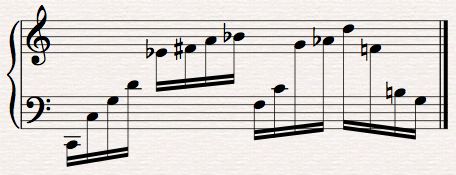The process of counting through a numbered array is independent of the contents of the array. The array could be an array of anything, and we could re-order or change the contents of the array and still employ the same process to read through it. So the counting process is necessary, but it's fairly uninteresting on its own. (At least, it's fairly uninteresting until we give it a more interesting rhythm than just reading at a constant rate.) The contents of the array are what's more important in determining the aesthetic of what is produced.
The program displays a sequence of 16 colors, 16 musical notes, and 16 positions for a black dot. Let's look at the colors first.
The color of the background of the lcd object is described by three numbers from 0 to 255 that state the value of Red, Green, and Blue in the mix. This is called RGB, and is one common way of describing colors digitally. The color values in the coll object were chosen to progress more-or-less directly through the color spectrum from red to green to blue and back toward red. Since there are 16 steps in the array, this naturally entails a few intermediate colors along the way. However, sixteen steps is way too few to give an impression of smooth gradual change; rather, we get a pattern of distinct colors that traverse the spectrum. And, if the program's looping feature is turned on, the pattern of colors seems to return fairly naturally to where it started.

The pattern of sixteen musical pitches is a little less direct, and a bit more complex. The first eight notes are an upward arpeggiation of the pitches C,C,G,D,Eb,F#,A,Bb, which could be thought of as a Cm13#11 chord. The next four notes are an upward arpeggiation of the pitches F,C,G,Ab, which could be thought of as an Fmadd9 chord (and/or, if we include the high D that comes next, as an Fm69 chord), and the final four notes are a downward arpeggiation of the pitches D,F,B,G, which is a G7 chord. So the sixteen-note pattern can be thought of as a i-iv-V progression in C minor, or, if we group the last eight notes together as one harmony, a i-V progression in C minor (Cm13#11 and G7b9). In terms of countour, the pattern is one long upward motion, followed by a second shorter upward motion, followed by a short downward motion. And, as with the colors, if the program's looping feature is turned on, the pattern makes a logical return to its starting point.

The pattern of sixteen velocities, if thought of as 16th notes in a 4/4 measure, show accents on beats 1 and 3, with a lesser accent on beat 2, and also strong syncopated accents on the 16th notes immediately preceding beats 1 and 3. When the program is in looping mode, this gives a pattern of rhythmic accents that essentially supports the harmonic rhythm, but that has enough sense of syncopation and ambiguity to keep the rhythm from being too ponderous.
The pattern of positions for the black dot has a strong correlation with the pitch contour and the harmonic rhythm of the musical notes, in the sense that it makes one generally upward motion in the first eight steps, followed by a shorter upward motion (reaching the highest point at the same time as the pitch contour does), and ending with a short downward motion. The first eight steps are in the left side of the lcd, and the second eight steps are in the right side, corresponding to the tonic-dominant harmonic interpretation. And, again, when looped, the pattern makes a continuous curve back to its starting point.
Try playing the patterns back at different rates (by changing the time interval of the metro) to get a sense of the way that rate affects the way we group events perceptually. For instance, at the default rate of eight events per second (i.e., with a 125 ms time interval) the notes are at a humanly-performable rate and the harmonic implication of them is quite clear; the movement of the black dot is a bit too jerky to be perceived as smooth movement. At a much faster rate like 25 events per second (a period of 40 ms), the motion of the dots seems smoother because the "frame rate" is too fast for us to perceive the locations as separate events; at this rate the musical effect of the notes is now also blurred and more merged as a single harmonic sound, although the pitch contour is still audible. At a slower rate like 2.5 events per second (400 ms per event), we still perceive the longer-term pattern of sixteen events, but each event feels more like an individual step or beat. In the case of the colors, this gives us more time to register a comparison between successive colors, thus perceiving the progression more clearly.

No comments:
Post a Comment